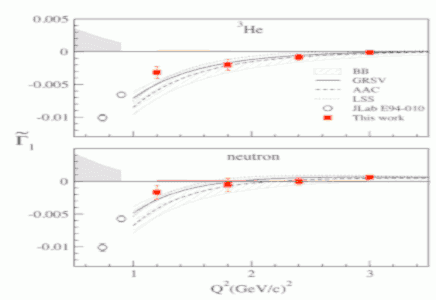Quark-Hadron Duality in Structure Functions

Additional Links
One of the principal challenges of QCD is to bridge the small- and large-scale behavior of the strong nuclear interactions. At short distances, perturbative QCD is very successful in describing nucleon structure in terms of quarks and gluons. At large distances, the effects of confinement impose a more efficient description in terms of collective hadron degrees of freedom. Despite this apparent dichotomy, an intriguing connection has been observed between the low- and high-energy data on nucleon structure functions, which is referred to as "quark-hadron duality."
A detailed experimental study performed in Hall C on unpolarized structure functions found that quark-hadron duality occurs at much lower momentum transfers, in more observables, and in far less limited regions of energy than expected.
More recently, the spin dependence of duality has been studied in Hall B for the proton and deuteron g1 structure functions and in Hall A for the neutron using 3He targets. The results of the E01-012 Hall A experiment suggest the appearance of duality in the neutron and 3He polarized g1 structure functions down to Q2 as low as 1.8 (GeV/c)2.
These results allow the first studies to be made of the spin and flavor dependence of quark-hadron duality and provide vital clues to the long-standing challenge of QCD to describe nuclear forces at large distances.
References:
P. Solvignon et al., Phys. Rev. Lett. 101 (2008) 182502
P. E. Bosted et al., Phys. Rev. C 75 (2007) 035203
W. Melnitchouk, R. Ent and C.E. Keppel, Phys. Rept. 406 (2005) 127

